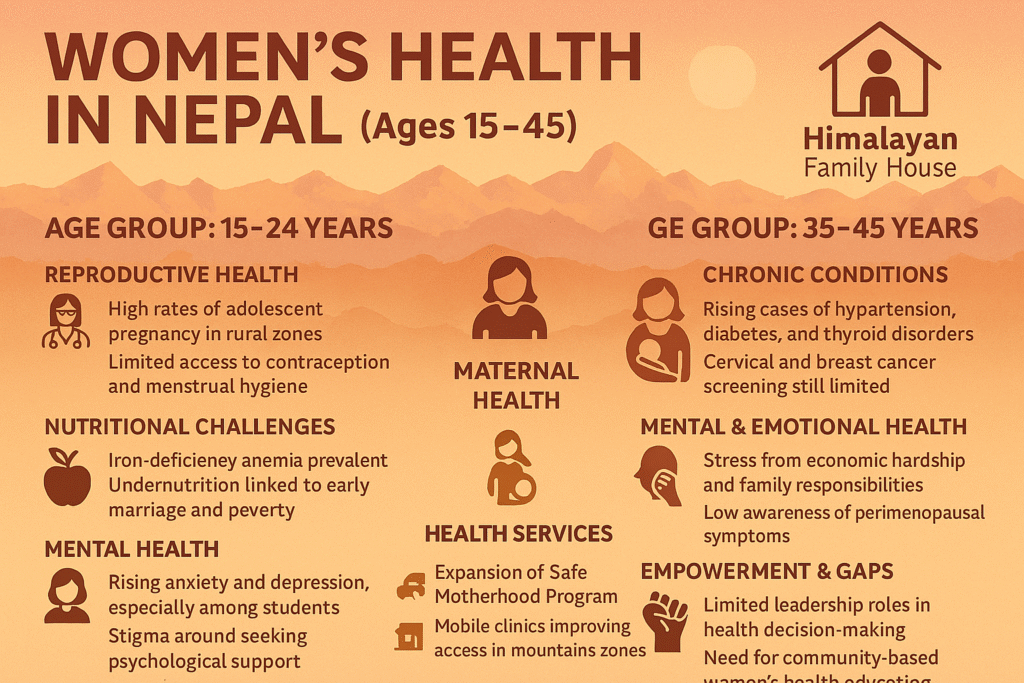
To visualize women’s health in Nepal for ages 15 to 45, we have created a comparative dashboard that highlights key dimensions across reproductive, nutritional, mental, and social health. Here’s a proposed structure for the campaign banner:
🩺 Women’s Health in Nepal (Ages 15–45)
By Himalayan Family House – For Regenerative Wellbeing
👩⚕️ Age Group: 15–24 Years
- Reproductive Health
- High rates of adolescent pregnancy in rural zones
- Limited access to contraception and menstrual hygiene
- Nutritional Challenges
- Iron-deficiency anemia prevalent
- Undernutrition linked to early marriage and poverty
- Mental Health
- Rising anxiety and depression, especially among students
- Stigma around seeking psychological support
- Social Factors
- School dropout due to marriage or menstruation taboos
- Gender-based violence and trafficking risks
👩 Age Group: 25–34 Years
- Maternal Health
- Major burden of childbirth and postnatal care
- Gaps in skilled birth attendance in remote areas
- Work & Family Balance
- Informal labor with no maternity protection
- Dual burden of caregiving and economic contribution
- Health Services
- Expansion of Safe Motherhood Program
- Mobile clinics improving access in mountainous zones
👩🦳 Age Group: 35–45 Years
- Chronic Conditions
- Rising cases of hypertension, diabetes, and thyroid disorders
- Cervical and breast cancer screening still limited
- Mental & Emotional Health
- Stress from economic hardship and family responsibilities
- Low awareness of perimenopausal symptoms
- Empowerment & Gaps
- Limited leadership roles in health decision-making
- Need for community-based women’s health education
🌄 Awakening Health Consciousness in Nepal: A Call to Local Government and the People
By Himalayan Family House — For Regenerative Wellbeing
In the sacred valleys and highlands of Nepal, where rivers whisper ancestral wisdom and mountains stand as sentinels of time, the health of our women—our mothers, daughters, and sisters—remains both a mirror and a measure of our nation’s integrity.
From adolescence to motherhood, and into the quiet strength of midlife, Nepali women carry the weight of generations. Yet too often, their health is neglected, their pain unseen, and their potential unrealized. It is time we rise—not just as policymakers, but as a conscious public—to restore dignity, vitality, and care to every woman between the ages of 15 and 45.
🏞️ For Local Governments: Stewardship Rooted in Service
Local governments are not merely administrative bodies—they are the custodians of communal wellbeing. To regenerate women’s health, we must:
- Establish Community Health Circles: Safe spaces for women to share, learn, and heal—led by trained local health workers and elders.
- Deploy Mobile Clinics in Remote Zones: Ensure access to reproductive care, cancer screening, and mental health support in every ward.
- Integrate Health Education in Schools: Normalize conversations around menstruation, nutrition, and emotional wellbeing from an early age.
- Support Female Health Workers: Empower local women as health ambassadors with training, stipends, and leadership roles.
Let every ward office become a sanctuary of care. Let every budget reflect the heartbeat of our mothers.
🌱 For the Conscious Public: A Cultural Shift Begins at Home
Health consciousness is not a policy—it is a practice. It begins in kitchens, classrooms, temples, and tea shops. As citizens, we must:
- Break the Silence Around Women’s Health: Speak openly about menstruation, mental health, and maternal care.
- Honor Traditional Wisdom with Modern Science: Blend herbal remedies and ancestral practices with evidence-based care.
- Support Local Health Campaigns: Volunteer, donate, and amplify initiatives like the Soil Health Card and Safe Motherhood outreach.
- Hold Leaders Accountable: Demand transparency, equity, and urgency in health-related decisions.
When the public becomes conscious, the nation becomes compassionate.
🕊️ Himalayan Family House: A Living Model of Regenerative Care
We invite every ward, every household, and every heart to join us in this movement. Through visual dashboards, community events, and intergenerational campaigns, we are weaving a new narrative—where health is not a privilege, but a promise.
Let the rising sun over the Himalayas remind us: regeneration begins with reverence. And reverence begins with care.
🌿 Engaging Local Communities in Health Initiatives
🏞️ 1. Root in Local Wisdom
- Honor traditional healers and elders as co-educators in health campaigns.
- Use local metaphors and folk stories to explain health concepts (e.g., comparing balanced nutrition to “a well-tuned madal”).
- Translate materials into local dialects and use visual storytelling for accessibility.
🧕 2. Empower Community Health Champions
- Train Female Community Health Volunteers (FCHVs) and youth leaders as frontline educators.
- Offer stipends, recognition, and leadership roles to sustain motivation.
- Create peer-to-peer circles where women and men share experiences and solutions.
🏡 3. Host Regenerative Events
- Organize health festivals alongside cultural or religious gatherings (e.g., NawaDurga RathaYatra).
- Combine free checkups, herbal workshops, and storytelling sessions in one communal space.
- Use music, dance, and art to make health joyful and memorable.
📊 4. Visualize Impact Locally
- Display community dashboards showing progress in immunization, nutrition, and maternal care.
- Use soil health cards, growth charts, and sunrise maps to make data tangible and inspiring.
- Celebrate milestones publicly—“100 mothers screened,” “50 youth trained,” etc.
🗣️ 5. Create Feedback Loops
- Hold monthly ward dialogues where citizens voice health concerns and co-design solutions.
- Use suggestion boxes, SMS polls, or village assemblies to gather input.
- Ensure visible follow-up so communities see their voices matter.
🤝 6. Build Intergenerational Bridges
- Pair elders with youth in health education teams.
- Encourage family-based health pledges—e.g., “Our household commits to clean water and iron-rich meals.”
- Document and share stories of healing and resilience across generations.
🌄 Himalayan Family House: A Model for Communal Integrity
By weaving health into the cultural fabric—through rituals, relationships, and regenerative design—we transform care from a service into a shared offering. Let every village become a sanctuary of wellbeing. Let every citizen become a steward of vitality.
